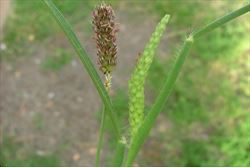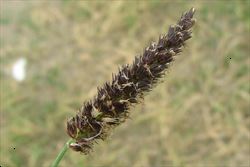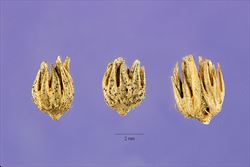Click on images to enlarge

infestation (Photo: Chris Gardiner)

habit (Photo: Sheldon Navie)

stems and leaves (Photo: Sheldon Navie)

young seed-heads (Photo: Sheldon Navie)

close-up of flower spikelets (Photo: Sheldon Navie)

immature seed-head (Photo: Sheldon Navie)

mature seed-head (Photo: Jose Hernandez at USDA PLANTS Database)

close-up of seeds (Photo: Jose Hernandez at USDA PLANTS Database)
Scientific Name
Cenchrus setigerus Vahl
Synonyms
Pennisetum setigerum (Valhl) Wipff
Cenchrus setiger Vahl
Cenchrus setigerus Vahl
Family
Gramineae (South Australia)Poaceae (Queensland, New South Wales, the ACT, Victoria, Tasmania, Western Australia and the Northern Territory)
Common Names
Birdwood grass
Origin
Native to north-eastern Africa (i.e. Egypt, Eritrea, Ethiopia, Somalia, Sudan, Kenya and Tanzania), the Arabian Peninsula (i.e. Yemen), southern Iran and the Indian sub-continent (i.e. India and Pakistan).
Naturalised Distribution
Naturalised in many parts of northern and central Australia. It is scattered throughout Queensland, the Northern Territory, the northern parts of New South Wales and the north-eastern parts of South Australia. However, it is most common in the northern and north-western parts of Western Australia.
Notes
Birdwood grass (Cenchrus setigerus) often dominates grasslands and the understorey layer of savanna woodlands in northern Australia. During a recent survey, this introduced grass was listed as a priority environmental weed in one Natural Resource Management region.
It is also common in coastal habitats and is ranked among the top ten environmental weeds in the coastal districts of the Kimberley and Pilbara regions of northern Western Australia. Birdwood grass (Cenchrus setigerus) is also regarded as an environmental weed in the desert uplands bioregion in Queensland and grows on red sandy soils in bimble box communities in inland New South Wales.

